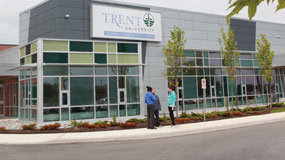

In Trent’s 2014 Strategic Mandate Agreement, the university administration made it clear that “develop[ing] strong partnerships and collaborations with external communities, professions, and other institutions” was going to be an important building block of the future.
Now, Trent is now taking its first steps towards achieving this vision as it is planning an important new capital project in conjunction with Durham College and the University of Ontario Institute for Technology (UOIT).
“Originally Trent wanted to expand on its own campus, but when that was not a possibility Trent joined with the two other institutions,” explained Joe Muldoon, Head of Trent University’s Oshawa Campus. Trent, Durham College and UOIT have all come together to plan a building that will be shared jointly between the three institutions to create a more cohesive and accessible learning environment for students.
By joining these three institutions together, a trifecta of education is created in a single space, marrying a university, a college, and technical institution, each with their own strengths. This collaboration will mean both additional spots for students and the facilitation of inter-institutional transfers.
Although Trent has existing ties with colleges such as Fleming, Durham, and Loyalist, this shared building will only increase the number of educational options for its students.
Trent also has ties with UOIT through the Trent-UOIT Synergy Project and according to last year’s SMA “the institutions are exploring a new level of systems thinking that brings individual institutional strengths in humanities, science, and social science.”
“There has always been collaboration between the institutions and the new building will likely lead to increased academic collaboration,” says Muldoon. “In 2014-15 Trent and UOIT developed a new joint Kinesiology program where students take the first two years at Trent Peterborough before moving to UOIT to finish their degree. Trent has recently signed a GAS (General Arts & Science) articulation agreement with Durham College that will allow students to do their first year at Durham and then transfer to Trent into second year.”
Muldoon guesses that the approvals from the government will come through sometime in the spring of 2015. If and when the proposals are approved the building will be 57,000 square feet and cost over $200 million dollars. “The current design has three buildings joined on the second floor,” he says. “The current Trent University Durham campus located at Thornton Rd. will continue to be the focal point of Trent University and new interdisciplinary programs in Child and Youth Studies and Cultural Heritage Management are being developed.”
With the new building comes the promise of more programs and “this process will create greater choice and mobility for students, increase research collaborations between the institutions, and increase inefficiencies,” explains Muldoon. “The Ontario Government is engaged in trying to make education more accessible.
They see the synergy amongst the three institutions (two universities and a college) as potentially a model for other institutions working together to make the system more student friendly with less duplication,” says Muldoon.
With more than 20 proposals being reviewed by the government at this time Trent is now waiting to receive approval for this major capital project.
If approved, this project could mark a major change in the direction of Trent University’s growth in the coming years.

